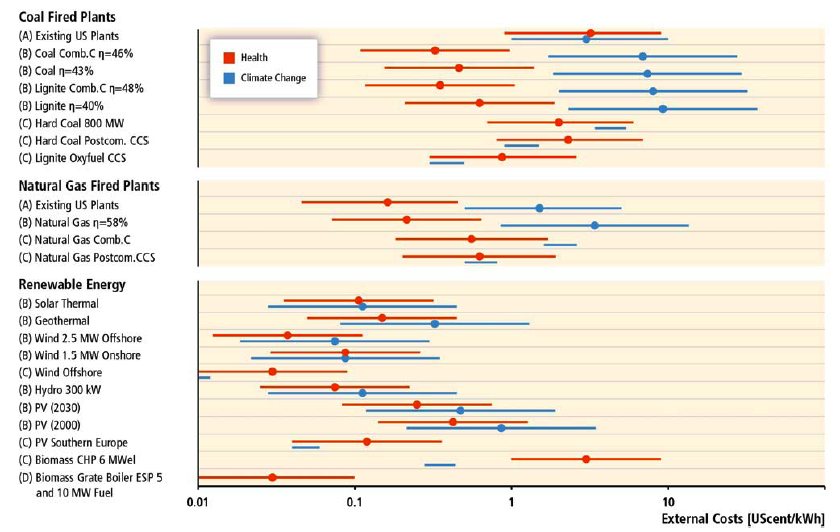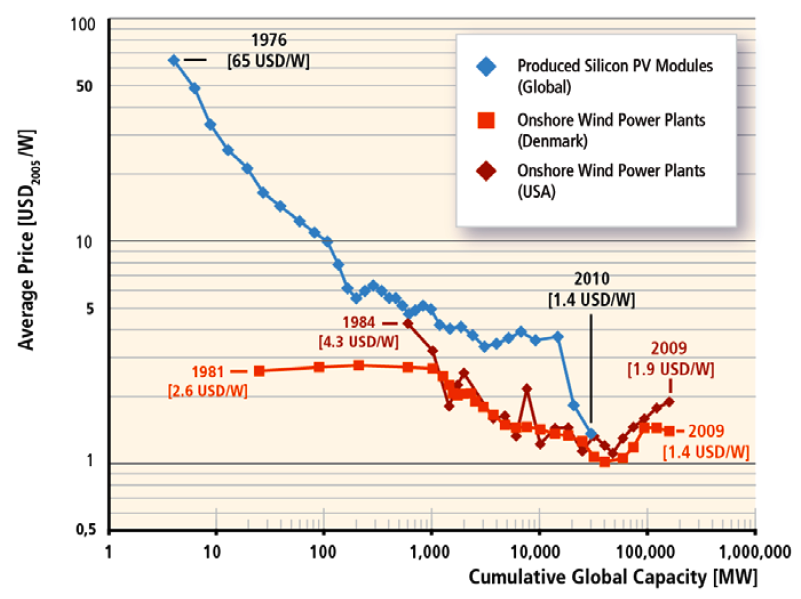IPCC Report on Renewable Energy
Posted on 22 June 2011 by dana1981, MartinS
The IPCC Working Group III recently released a Special Report on Renewable Energy Sources and Climate Change Mitigation (SRREN). The purpose of this report is to provide an assessment and thorough analysis of renewable energy technologies and their current and potential role in the mitigation of greenhouse gas emissions. The report focused on what is technically and economically feasible.
Among the most significant conclusions in the report is that we could meet as much as 43% of global energy demand with renewable sources by 2030, and up to 77% by 2050 (renewable energies accounted for 13% in 2008), although based on the bulk of the 164 scenarios examined, closer to 30% renewable penetration appears more realistic. Certain individuals have attempted to manufacture controversy about the 77% renewable penetration scenario (see the associated McManufactured Controversy' post), but in reality it's not even a terribly aggressive target from a technological standpoint. For example, we have previously discussed the Ecofys plan to meet 100% of global energy demand with renewables by 2050, and the Jacobsen and Delucchi plan to meet 100% of demand with just wind, water, and solar energy in 2050 (also see the Advanced rebuttal to "Renewables can't provide baseload power"). Compared to those plans, a 77% goal is relatively muted. It may be unrealistic from a political standpoint, but that question is beyond the scope of this report.
According to SRREN, renewables are already developing rapidly. Of the 300 gigawatts (GW) of new electricity-generating power plants added globally from 2008 to 2009, nearly half (140 GW) came from renewable sources. In the European Union, the share of renewable to total energy installment was even higher, at 62%.
The report also found that global availability and obtainability of renewable energy will not limit continued growth, because the global technical potential exceeds the primary energy use, which was 492 exajoules (EJ = 1018 Joules) in 2008 (Table 1).

Table 1: Global technical potential from various renewable energy sources
SRREN found that sufficient investments in renewable energy to stabilize atmospheric CO2 levels at 440 ppm (approximately corresponding to the 'danger limit' of 2°C warming above pre-industrial levels) would cost approximately $5.1 trillion from 2011 to 2020 and $7.2 trillion from 2021 to 2030, globally. Although it sounds like a large amount of money, this represents less than 1% of the global gross domestic product (GDP).
The report also notes that as we have previously discussed, the external costs of coal combustion (primarily due to health impacts and climate change), which are not currently reflected in the market price of coal power, increase the true cost of coal several times over. The external costs of renewable energy sources are much lower (Figure 1). While the external costs for coal fired power plants are at least 7.2 cents per kilowatt-hour (kWh), they are less than 0.2 cents/kWh for wind turbines. If the external damages are considered costs of wind energy are likely cheaper than those of coal energy (Jacobson and Masters 2001).
Figure 1: Illustration of external costs due to the lifecycle of electricity production based on renewable energy and fossil energy. Note the logarithmic scale of the figure. The blue lines indicate the range of the external cost due to climate change and the red lines indicate the range of the external costs due to air pollutant health effects.
An argument that many "skeptics" like to make (including John Christy) is that historically, economic development has been strongly correlated with increasing energy use and growth of greenhouse gas (GHG) emissions. This is true, since the majority of energy production has historically come from fossil fuels. Thus, the "skeptics" argue, transitioning away from fossil fuels to renewable energy will cripple the economic growth of developing nations.
However, this is simply a logical fallacy. Economic growth correlates well with energy use, but there's no reason that energy has to come from fossil fuels. It's just that historically, the market price (though not the actual net cost) of fossil fuels has been very low. However, the SRREN notes that renewable energy can help decouple that correlation between economic growth and GHG emissions, contributing to sustainable development. Another key to meeting increasing energy mands from developing countries with renewable power is the rapidly decreasing cost of these technologies, particularly solar photovoltaic (Figure 2).
Figure 2: Decreasing average price of solar PV and wind as global installed capacity of these technologies has grown
Of course it's not all sunshine and rainbows. Meeting the $5.1 trillion global renewable energy investment from 2011 to 2020 will require a five-fold increase from current investment levels. And of course there is the political challenge involved in implementing the necessary policies to allow this renewable energy investment increase to happen. For example, putting a price on carbon emissions, which will more accurately reflect the true cost of fossil fuel combustion in their market price, and make renewable energy more financially competetive. However, even though doing so would be economically beneficial, as the SRREN notes, there is a great deal of political resistance to implementing a carbon price in many countries.
To sum up, in this report the IPCC finds that we can give ourselves a chance to keep global warming below the 'danger limit' with an investment of less than 1% of global GDP in renewable energy. This will also help us de-couple economic development from GHG emissions, and in fact will benefit the economy by avoiding the harm to public health and the climate associated with burning fossil fuels. However, accomplishing this major transition from fossil fuels to renewable energy will be very challenging, particularly from a political standpoint in terms of implementing the necessary policies.
NOTE: We have also written a sister post regarding the McManufactured Controversy associated with SRREN































 Arguments
Arguments

























 0
0  0
0






Comments